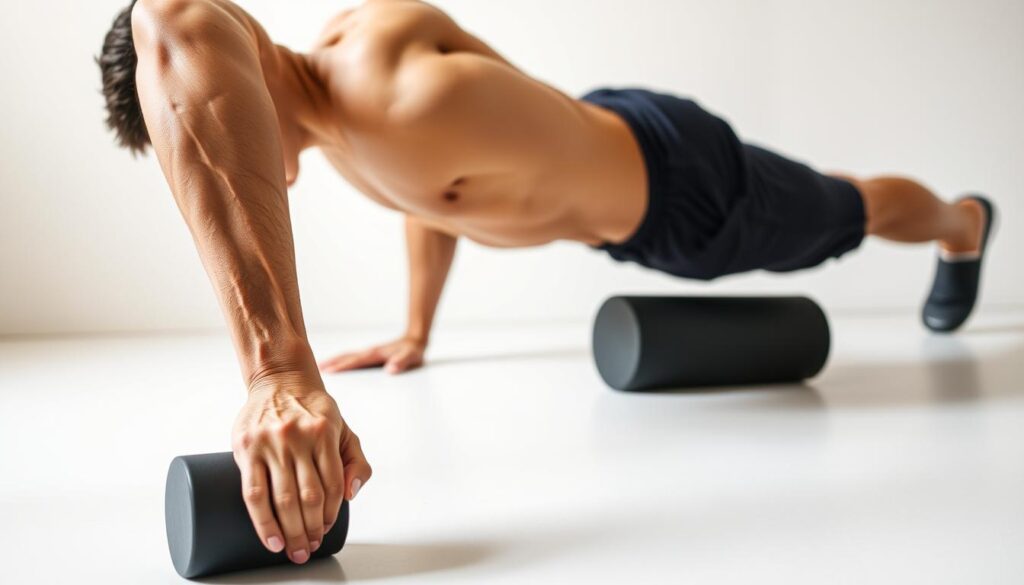Neck pain is a widespread issue today, especially for those who sit a lot or have bad posture. Foam rollers have become a favorite way to handle pain and help muscles recover. We’ll show you how these handy self-massage tools can ease neck pain, making you more relaxed and flexible. Adding foam rolling to your daily habits can help reduce pain and boost your health.
Understanding Foam Rollers
Foam rollers are must-have items for personal wellness, offering a way to massage yourself. They are available in a variety of types, designed to meet specific needs. You can find them in soft, firm, or textured forms, each offering a different massage intensity.
They mainly help ease muscle tension. Using foam rollers can increase blood flow and make muscles more flexible. They also help keep joints healthy, which is great for athletes and active people.
Adding foam rollers to your daily routine boosts recovery and helps keep your body in good shape. Knowing the types of foam rollers can make your recovery sessions more effective. It allows for a customized approach to muscle recovery and flexibility. With correct use, they’re beneficial tools for enhancing physical health.
How Foam Rolling Works for Neck Pain Relief
Foam rolling is a great way to ease neck pain. It’s like giving yourself a massage to loosen tight muscles. When you press on sore spots, you help your muscles relax. This also boosts blood flow and makes you more flexible.
Regularly using foam rollers can make you feel a lot better. Key moves to help with pain are:
- Rolling slowly over tight spots to break down muscle knots
- Maintaining pressure on especially sore areas for 30 seconds to a minute
- Incorporating deep breathing to help you relax more while you roll
Foam rolling is easy and safe for most people. It helps prevent and treat neck pain. When trying it, pay attention to what your body tells you. This will help you get the best results.
Neck Pain Relief Using Foam Rollers
Foam rollers are great for easing neck pain. They help through soft tissue massage and applying pressure. This helps to reduce discomfort and boosts quality of life. Using foam rollers can also fix posture problems, which often cause neck pain.
Using foam rollers makes your neck more flexible. When your neck moves better, you feel better. As you relax during foam rolling, neck tension fades. This makes moving easier and more comfortable.
Adding foam rolling to your daily routine helps in two ways. It eases pain and helps muscles recover. This method not only helps muscles heal but also relaxes them. This can make your neck feel a lot better overall.
Choosing the Right Foam Roller
Choosing the right foam roller can make a big difference in easing neck pain. There are many types, each with its own density, size, and shape. It’s key to know about these differences. Understanding how dense a foam roller is will tell you how much pressure it puts on your muscles.
For those new to foam rolling, a softer roller is a good start. Soft rollers are gentler on muscles, making it easier for beginners. As you get used to it, a firmer roller can give a deeper massage. For the most experienced, rollers with special designs can make the massage even better.
Here’s what to think about when picking a foam roller:
- Density options: Choose softer rollers for beginners and denser ones for experienced users.
- Shape and size: Select rollers that fit your body’s needs, like long rollers for big muscle groups or small rollers for specific spots.
- Surface texture: Look at rollers with special textures for better muscle relief.
Keeping these points in mind while choosing will improve your foam rolling experience and help with neck pain. Finding the right type of foam roller for you means better results and enjoying it more.
Essential Foam Rolling Techniques for the Neck
Foam rolling helps soothe neck pain, especially when you find trigger points. Learning the right neck rolling ways can make muscle release better. Here are steps to smartly find and work on tense spots in the neck.
Start in a comfy spot. Sit straight with your back propped up or lay flat. Gently rest the foam roller under your neck, in line with your spine.
Then, gently roll your head over the foam roller. This helps find trigger points and lets you check the best pressure. Be sure to keep the pressure light to not hurt yourself.
As you roll, pay more attention to spots that feel stiff or sore. These spots usually need extra focus. Rest the roller on these areas for 15 to 30 seconds to let the tightness ease.
Try moving your head side to side, as if looking over each shoulder. This helps release the muscles further and boosts neck movement.
Keep doing these exercises regularly. Using these foam rolling methods often can ease neck pain. It also helps keep your neck moving freely and stops tightness from coming back.
Integrating Foam Rolling into Your Routine
Adding foam rolling to your daily habits can boost your health. It helps muscles recover faster and reduces stress. This makes foam rolling a key part of taking care of yourself.
Here are some tips to make foam rolling a natural part of your day:
- Frequency: Try to use your foam roller at least three times each week. More often is even better if you can find the time.
- Timing: Foam roll before your workout to prepare muscles, or afterwards to help with recovery and increase flexibility.
- Duration: Focus on specific areas for 10-15 minutes per foam rolling session to get the most out of it.
- Consistency: Make foam rolling a must-do in your daily schedule, just like exercising or eating right.
- Balance: Combine foam rolling with other activities, such as yoga or lifting weights, to get even more benefits.
Making foam rolling part of your everyday life leads to better health. With time, this simple self-care action can change how you feel, both body and mind.

Complementary Techniques for Neck Pain
Adding certain stretching methods can really boost how well foam rolling eases neck pain. The right stretches focus on the neck and shoulders. They work well with rolling to help muscles relax more.
Here are some great stretches to do with foam rolling for better flexibility:
- Chin Tucks: Sit or stand straight. Tuck your chin down gently, and hold. This eases tension.
- Side Neck Stretch: Lean your head to one side, touching your ear to your shoulder. Hold, then do the other side to stretch both.
- Upper Trapezius Stretch: Sit and reach one arm out. Then tilt your head away. This stretches your shoulder and neck.
- Neck Rotations: Turn your head in circles slowly. This loosens stiffness and helps blood flow.
Using these stretches with foam rolling helps muscles recover better and eases pain. Doing both regularly keeps your neck healthy. It lets you move more easily and feel more relaxed overall.
Common Mistakes to Avoid While Foam Rolling
People use foam rolling to feel better, but making mistakes can lower its benefits or increase injury risks. Knowing these errors can make foam rolling more effective and safer.
Pushing too hard is a big mistake. It’s important to apply enough pressure to work out muscle knots. But, applying too much force can cause discomfort or injury. Use a level of pressure that feels good and helpful, not painful.
Using the wrong technique is also a problem. Rolling too quickly or in the wrong position won’t target tight muscles well. Focus on putting pressure on sore spots slowly and with control. Spending more time on tight areas can help relieve them more.
Only focusing on one part of the body, like the neck, is another error. This can leave other connected muscles tense. Including other areas, like the upper back and shoulders, in your foam rolling can relieve more muscle tightness.
- Monitor your pressure levels.
- Ensure proper body alignment.
- Slow down your rolling motion.
- Incorporate rolling for various muscle groups.
Avoiding these mistakes will make foam rolling safer and work better. This improves your health and wellness journey.
Conclusion
Foam rolling is great for easing neck pain and boosting well-being. It’s important to roll foam into your daily habits. Doing it often can give quick relief and help your health over time. This makes it key for neck pain care.
Foam rolling stands out for being easy for everyone to try. Picking the right roller and using it correctly matters. Pay attention to your body and add foam rolling to your health routine for better neck ease.
Using these tips, you can better manage your neck pain. Start now to see the good changes it brings to you. Making health a priority with these methods means a happier, more active way of living.



